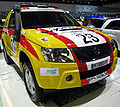2007 Suzuki Grand Vitara Owner's Manual - Page 165
2007 Suzuki Grand Vitara Manual
Page 165 highlights
INSPECTION AND MAINTENANCE Power Steering (if equipped) Clutch Pedal Tires For safe operation of your vehicle, it is important that the tires be the correct type and size, in good condition, and properly inflated. Be sure to follow the requirements and recommendations in this section. (1) Tire Sidewall Labeling Useful information about a tire is molded into its sidewall. The example below shows a typical passenger car tire. (2) Typical Passenger Car Tire Sidewall 64J155 C 64J154 I D J (1) UPPER (2) LOWER Check the steering box case, vane pump and hose connections for leaks or damage. Power Steering Fluid Check the fluid level by looking at the reservoir in the engine compartment when the fluid is cold (about room temperature). Check that the fluid level is between the (1) and (2) lines. If the fluid level is near the (2) line, fill it up to the (1) line with an automatic transmission fluid equivalent to ATF DEXRON®-II (Esso JWS 2326) or DEXRON®-III. Do not overfill. Check the clutch pedal for smooth operation and clutch fluid level from time to time. If clutch dragging is felt with the pedal fully depressed, have the clutch inspected by your SUZUKI dealer. If the clutch fluid level is near the "MIN" line, fill it up to the "MAX" line with DOT3 brake fluid. B H G A E F EXAMPLE 67D027 A. Tire Manufacturer The name of the tire manufacturer is shown here. B. Tire Name/Model The tire name or model is shown here. 9-24
















